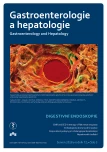Is Amanita phalloides poisoning still a problem?
Authors:
F. Nehaj 1; J. Krivuš 2; Mi. Mokáň 1; M. Kubašková 2; J. Sokol 3; P. Galajda 1; F. Kovář 1; M. Péč 4; Ma. Mokáň 1
Authors‘ workplace:
I. Interná klinika JLF UK a UN Martin
1; Radiologická klinika JLF UK a UN Martin
2; Klinika hematológie a transfuziológie, Národné centrum hemostázy a trombózy JLF UK a UN Martin
3; JLF UK v Martine
4
Published in:
Gastroent Hepatol 2018; 72(3): 257-259
Category:
doi:
https://doi.org/10.14735/amgh2018csgh.info05
Overview
Mushroom poisoning is one of the most common acute events. From an epidemiological viewpoint, accidental fungal poisoning occurs frequently in the Slovak Republic, especially during the main growing season of mushrooms in the summer and autumn. Intoxication is divided into several stages with typical symptoms. Several types of syndromes develop according to the type of fungus, the mycotoxins it contains, and the symptoms. These include gastroenterodyspeptic, muscarinic, psilocybin (psychotropic), mycoathropin-neurotoxic, gyromitrin-hepatotoxic, phaloid-hepatorenal, antabus, and orelanin-nephrotoxic syndromes. The fungus should be correctly identified in cases of mushroom poisoning. However, this is not possible in most cases for several reasons. The patient or doctor often lacks sufficient knowledge or theoretical and practical experience of recognizing mushroom species. Clinical pharmacologists and toxicologists can identify mushrooms based on their microscopic and macroscopic characteristics. The type of mushroom is unknown in 95% cases of mushroom poisoning. Amanita phalloides is one of the most poisonous mushrooms and is the cause of the majority of human deaths due to mushroom poisoning worldwide. The liver is the main target organ of toxicity, but other organs, especially the kidneys, are also affected. Intoxication symptoms usually appear after a latent period and may include gastrointestinal disorders followed by jaundice, seizures, and coma, culminating in death. Therapy consists of supportive measures, gastric decontamination, drug therapy, and ultimately liver transplantation if the clinical condition worsens. If necessary, the National Toxic Information Centre in Bratislava or other centers in neighboring countries can be contacted. We present a case report of Amanita phalloides poisoning, diagnostic methods, treatment options, and a review of the literature.
Key words:
Amanita phalloides – amanitin – dyspepsy – hepatic enzymes
The authors declare they have no potential conflicts of interest concerning drugs, products, or services used in the study.
The Editorial Board declares that the manuscript met the ICMJE „uniform requirements“ for biomedical papers.
Submitted: 14. 12. 2017
Accepted: 30. 1. 2018
Sources
2. Jaeger A, Jehl F, Flesch F et al. Kinetics of amatoxins in human poisoning: therapeutic implications. J Toxicol Clin Toxicol 1993; 31 (1): 63–80.
3. Enjalbert F, Rapior S, Nouguier-Soulé J et al. Treatment of amatoxin poisoning: 20-year retrospective analysis. J Toxicol Clin Toxicol 2002; 40 (6): 715–757.
4. Kantola T, Kantola T, Koivusalo AM et al. Early molecular adsorbents recirculating system treatment of Amanita mushroom poisoning. Ther Apher Dial 2009; 13 (5): 399–403. doi: 10.1111/j.1744-9987.2009.00758.x.
5. Karlson-Stiber C, Persson H. Cytotoxic fungi – an overview. Toxicon 2003; 42 (4): 339–349.
6. Magdalan J, Ostrowska A, Piotrowska A et al. Benzylpenicillin, acetylcysteine and silibinin as antidotes in human hepatocytes intoxicated with alpha-amanitin. Exp Toxicol Pathol 2010; 62 (4): 367–373. doi: 10.1016/j.etp.2009.05.003
Labels
Paediatric gastroenterology Gastroenterology and hepatology SurgeryArticle was published in
Gastroenterology and Hepatology

2018 Issue 3
Most read in this issue
- Vistaprep – the standard of bowel preparation before colonoscopy
- A tumorous atrioesophageal fistula as an unusual cause of septicemia
- Is Amanita phalloides poisoning still a problem?
- Experience in the treatment of severe bleeding in Crohn’s disease with anti-TNF therapy
